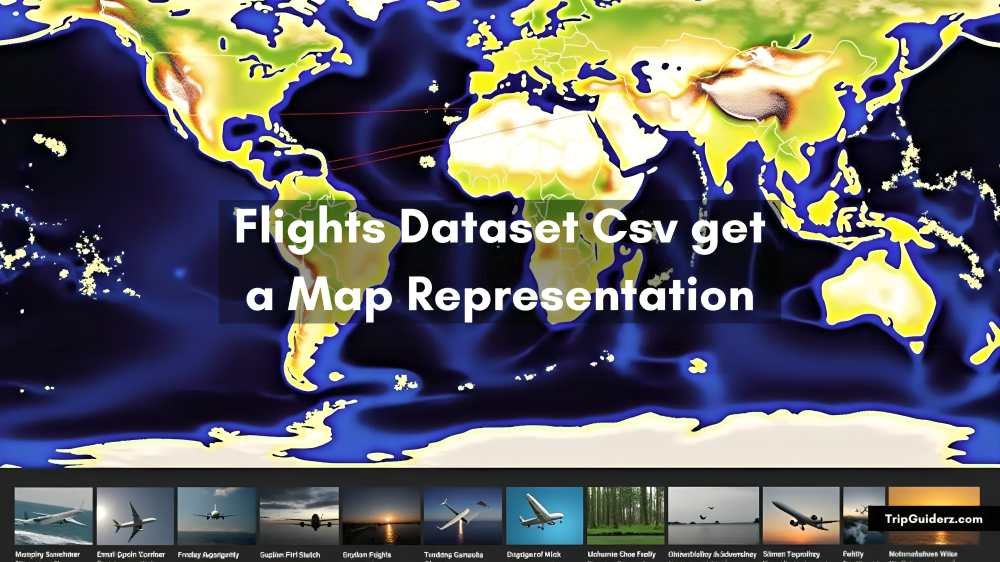Introduction to Flights Dataset Csv get a Map Representation: It is easier to understand different trends and patterns when using mapping data. The dataset that can be used for this purpose is the flight dataset CSV. This dataset gives specific information about different flights, including the routes they cover as well as the timetables.
Having displayed this data on a map you can watch the flight routes, find the most frequent and popular ones, and see the general movement of passengers. In this post, I will explain how to get a flight dataset in CSV format, how to plot it on the map, and why such data is useful in the analysis.
Understanding Flights Dataset CSV Get a Map Representation: An Overview
A Flights Dataset Csv gets a Map Representation is a standard file that records important information about flights. It can contain columns like flight number, origin and destination airports, flight time, and date of the flights. Every row is a single flight which makes it a valuable data source.
To analyze this dataset one must know what the dataset contains. Key columns often found in a flights dataset CSV include:
- Flight Number: A reference number assigned to each flight.
- Departure Airport: The airport from which the particular flight is to be taken off.
- Arrival Airport: The airport that the flight is heading to.
- Departure Time: The time that was planned for traveling.
- Arrival Time: The time that the vehicle is anticipated to arrive at the destination.
Where to Obtain Flights Dataset CSV Get a Map Representation for Your Data Analysis?
For the detailed analysis, one must get a Flights Dataset Csv to get a Map Representation. Here are several methods to acquire it:
- Public Datasets: The datasets on the flights can be easily accessed from websites such as Kaggle and Open Data Portal in CSV format. All of these platforms contain a large number of datasets that are available for download on the platforms.
- Airline Websites: Few airlines provide flight information to the public. One can look for any available datasets on their websites through the official links.
- Government Aviation Authorities: There are bodies in most countries that are responsible for statistics on aviation. These agencies may release databases for public consumption.
- Data Scraping: In case the data is not easily accessible, it is possible to use screen scraping techniques that allow the extraction of flight data from airline companies’ websites or online travel agencies.
Once you are done, look for a reliable source, and download the flight dataset CSV to start your analysis.
How to Plot Flights Dataset CSV Get a Map Representation?: A Tutorial
Using a map to display a Flights Dataset Csv get a Map Representation is quite simple. Follow these steps to create a visual representation:
- Prepare Your Data: locate your data for flights in a csv file and open it in a spreadsheet application. Make sure that the departure and arrival airports are correctly stated, and their codes are provided.
- Select a Mapping Tool: Select a mapping tool of your choice and it could be Google Maps, ArcGIS, or Tableau. These tools include the import of CSV files and the mapping feature.
- Upload Your Data: Choose the mapping tool of your preference and upload your flight dataset CSV. Please refer to the tool guidelines on how to input and arrange the data to be used.
- Map Your Data: Use the features of the tool to draw flight paths. Normally the user will choose the columns that represent the points of departure and arrival. The tool will be able to produce a graphical view of the flights.
- Customize Your Map: Most of the mapping tools allow the user to set up the map appearance in some way. Modify colors, legends, and symbols for better clarity.
- Analyze the Map: After creating the map you are in a position to analyze the visual data that has been displayed. Search for patterns like the most often used paths or the frequency of flights between two particular airports.
This way, you can easily plot your flight dataset CSV on a map and get the desired visualization.
This paper will use a Map for the Flights Dataset CSV since
There are several advantages when mapping flight dataset CSV. It is much easier to notice patterns in your data when it is graphically displayed rather than when it is entered into a spreadsheet. Here are some reasons to use a map:
- Identify Trends: Maps also show the most frequent flight paths and the regions with a high level of traffic. This data will be useful for airlines that want to improve their route networks.
- Regional Insights: You can distinguish the traveling trends in different areas. This assists in the identification of market trends and preferences of the passengers.
- Decision-Making: Thus, airlines and travel agencies can use the visual data and make decisions. For example, identifying the under-served routes can result in new flights.
- Engagement: While using interactive maps is more effective than using static charts, it is also cheaper. It enables users to navigate through data in a more friendly way.
Using maps can discover trends that will allow for enhanced decision-making and planning.
Methods and Programs for Generating Flights Dataset Csv get a Map Representation.
Several tools are available to create a map from a flight dataset in CSV format, these are: Here are some popular options:
- Google Maps: A tool to visualize points on a map from a CSV file. You can display routes and share your maps with your friends.
- Tableau: A feature-rich data visualization tool that also includes mapping functionality. It is possible to design detailed and engaging maps that will help represent flight data in the best way.
- ArcGIS: A mapping system that has enhanced geographic analysis tools as its primary goal. It is suitable for users who require advanced mapping features in their work.
- QGIS: One of the open-source GIS software that can be used to capture, store, display, manipulate, and analyze geo-referenced information.
- Microsoft Power BI: This tool has mapping functions integrated into it together with its data visualization functions. It is possible to generate maps that can be connected to other analytical tools so that data can be analyzed together.
The choice of the tool depends on what you want to achieve, the level of complexity of your analysis, and your experience with the software.
Interpreting Data: Conclusion of the Analysis of Flights Dataset Csv get a Map Representation
Therefore, after creating a map from flights dataset CSV, it becomes necessary to understand the data displayed. Here are some key insights you can glean from the visualization:
- High-Traffic Routes: Find out the routes with the most frequency of flights. This depicts some of the most visited areas and assists airlines in their planning of their flight timings.
- Peak Travel Times: Identify the time of the year that has the highest and the lowest travel activity. This will allow airlines to know the best time to allocate their resources to meet the needs of the consumers.
- Route Efficiency: Compare the time taken by flights and the time taken by the flights to identify the effectiveness of the routes. This information is useful to enhance the operational efficiency.
- Geographic Trends: See whether there are any patterns in the flight data by region. Some areas may exhibit high levels of movement which is an indication for potential expansion.
With these findings, it becomes possible for the stakeholders to make necessary changes to their services and operations.
Some of the biggest errors that occur when mapping flight dataset CSV and how to avoid them?
It is not always easy to perform an analysis on a flight dataset CSV file. Here are some common mistakes and how to avoid them:
- Incorrect Data Formatting: This will also include checking for the right format of airport codes and numbers of the flight. Conflicts can result in producing wrong connections.
- Overlooking Data Quality: It is always recommended to check your data for its authenticity. Spurious or missing information may cause incorrect visual representations of data.
- Ignoring Scale and Legend: When you are drawing maps, make sure to provide a scale and also a key. This enables the audience to have a clue about the map and the information displayed thereon.
- Failing to Customize: Do not use standard map views. Adding options to your map makes it easier to read and understand and makes it easier for the viewers to try to understand the data.
Knowing these potential problems enables you to design sound and useful maps that represent data for users effectively.
Real World Implementations of Flights Dataset Csv gets a Map Representation
The application of a flight dataset CSV mapped representation ranges from one industry to another. Here are some real-world uses:
- Airline Operations: These maps are applied in Airlinestoo to determine the appropriate routes and timetables. This way they can track the most profitable routes that a specific flight takes.
- Travel Agencies: It also enables agencies to map out trends in travel to effectively advertise top destination sales to boost business.
- Research and Academia: This data is very useful for the researchers to make various analyses like tourism effects or environmental effects from aviation industries.
- Government and Policy Making: Flight data can be useful for government agencies in analyzing travel behaviors to influence transport polity and constructs.
These applications demonstrate the utility and use of mapping flight data in the real world.
Improving Your Flights Dataset CSV Get a Map Representation
With the help of interactive maps, data analysis can be carried out to another level. They enable the users to interact with the data more interactively hence offering better understanding. Here’s how to enhance your analysis using interactive maps:
- Add Filters: You should implement some checkboxes/fields to enable users to choose a particular flight or period. This is something that helps in the analysis process.
- Enable Clickable Features: Provide options for users to either click on a route or an airport to be presented with more information like the frequency of flights or any possible delays.
- Integrate Real-Time Data: Integrate APIs that will enable your maps to display real-time flight information. This integration allows you to always have the most recent and accurate maps.
- Utilize Color Coding: Commonly, color codes can be used to denote different information like delays or traffic throughout the year. This graphical aid allows users to easily understand the data presented to them.
When you add interactivity to your analysis with the users engaged in exploring the flight dataset CSV, you give them a better experience.
Conclusion
This paper demonstrates how visualization of flight dataset CSV can be useful in analyzing flight data. In navigation, tracking the movement of organisms or animals to even planning and executing a business move, mapping is very helpful.
If you have read this article to the end, you will be able to produce useful and interesting maps for data visualization. If you are an airline, travel agency, or even a researcher, using these tools will enhance your knowledge of flight dynamics and trends.
FAQs:
Q1: What does a Flights Dataset Csv get a Map Representation mean?
A flight dataset CSV is a formatted file that contains flight information including flight numbers, airports, and timings.
Q2: Where can I find a Flights Dataset Csv to get a Map Representation?
To get the flight dataset CSV that is to be used in this example, the files can be downloaded from public data sources, airline websites, or even from government aviation agencies.
Q3: How can I represent the Flights Dataset Csv get a Map Representation on a map?
The most common tools for mapping the flight data that are used include Google Maps, Tableau, and ArcGIS among others.
Q4: What is the advantage of Flights Dataset Csv getting a Map Representation?
Flight data is more easily understood when it is portrayed graphically in the form of a map, as compared to when it is presented in tabular format.
Q5: Is it possible to make maps out of the Flights Dataset Csv to get a Map Representation?
Yes, many of the mapping tools out there offer the ability to make maps that can be ‘played with’ by the user and allow for further analysis.






